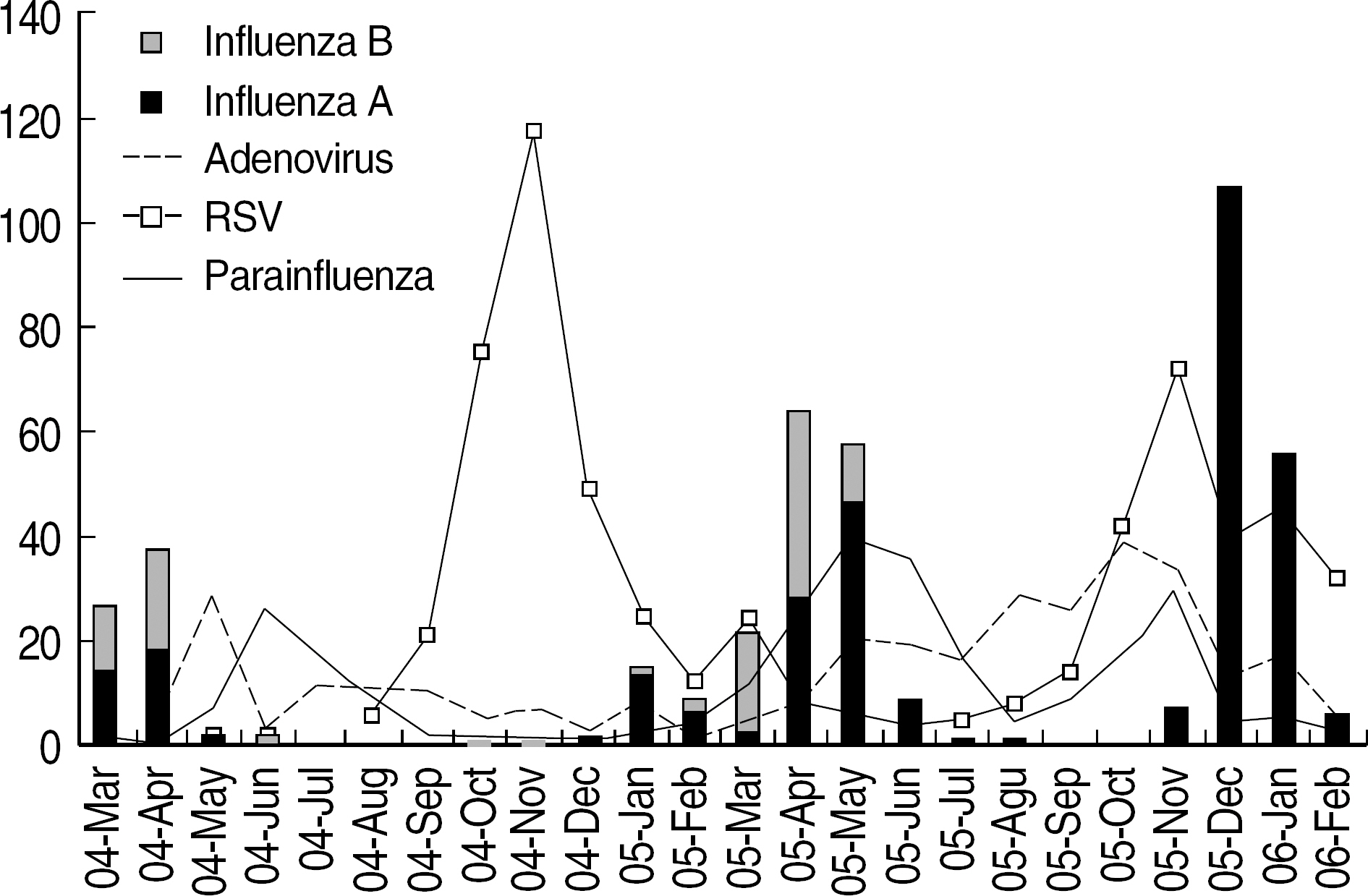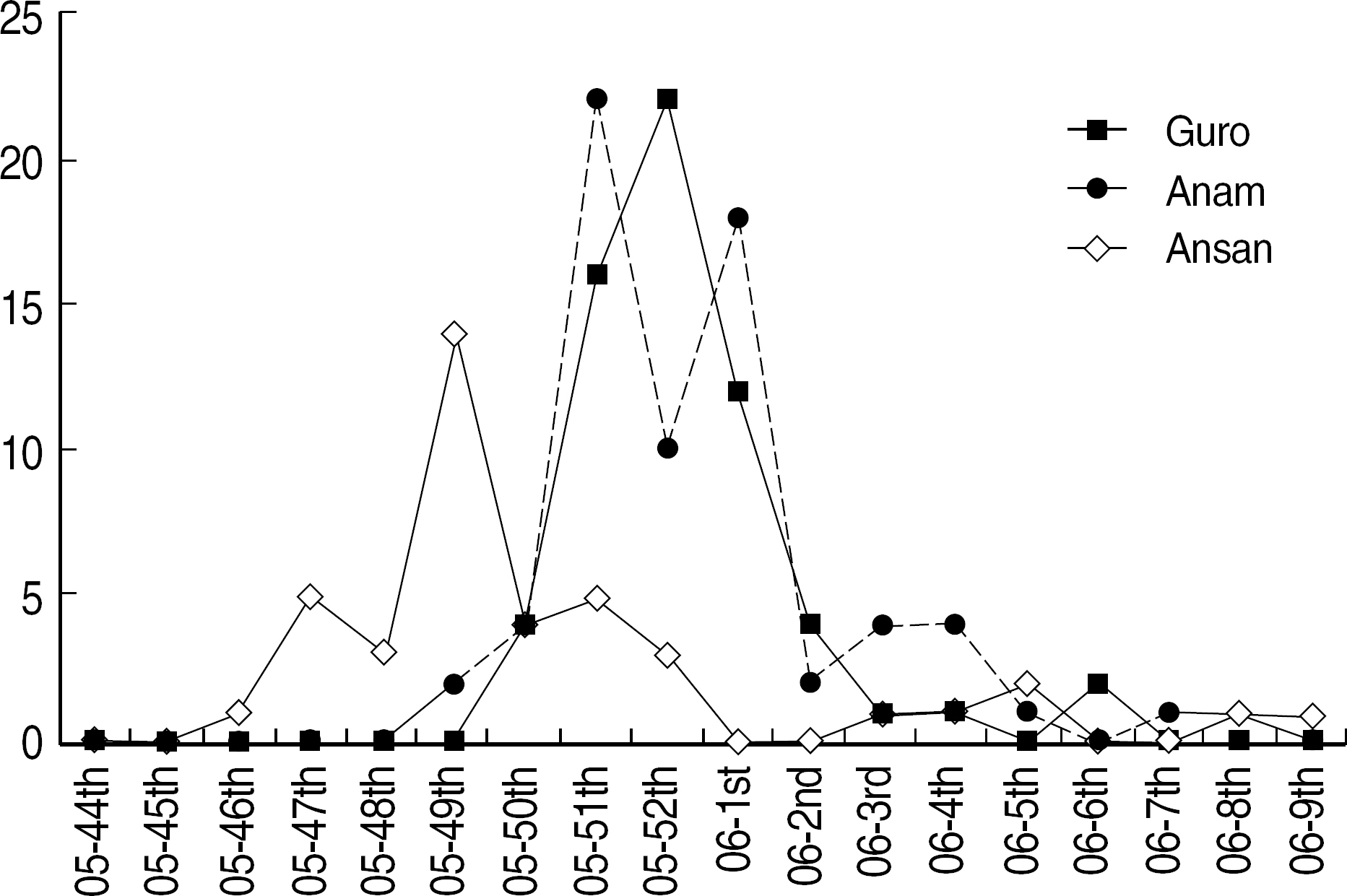Epidemiology of Respiratory Viral Infection in 2004-2006
- Affiliations
-
- 1Department of Laboratory Medicine, College of Medicine, Korea University, Seoul, Korea. cklee@korea.ac.kr
- KMID: 2238852
- DOI: http://doi.org/10.3343/kjlm.2006.26.5.351
Abstract
-
BACKGROUND: The information on the incidence, seasonal variation and clinical pattern of respiratory virus infections is very important for clinicians in managing their patients. This study was aimed to define the epidemiology of respiratory viral pathogens in Seoul and the neighboring areas from March 2004 to February 2006.
METHODS
A total of 6,533 specimens were cultured for respiratory viruses during the study period. Madin-Darby canine kidney (MDCK), LLC-MK2, and HEp-2 cells, or R-mix cells (Diagnostic Hybrids Inc., Athens, Ohio, USA) were used for culture. Influenza virus types A & B (Inf A & B), parainfluenza virus (PIV), respiratory syncytial virus (RSV), and adenovirus (ADV) were identified by indirect immuno-fluorescent staining. Medical records of the patients with positive virus cultures were reviewed retrospectively.
RESULTS
One or more viral agents were isolated from 1682 specimens (25.7%). The pathogens identified were RSV 37.2%, ADV 19.9%, Inf A 18.9%, PIV 17.5% and Inf B 6.4%. The most frequent pathogen of pneumonia and acute bronchiolitis was RSV and that of croup was PIV. Upper respiratory tract infections were more prevalent in adults and the most frequently caused by influenza virus. Influenza virus itself was more frequently isolated in children less than six years old, which was different from previous reports. Influenza virus was mostly isolated in the winter and spring, while RSV was usually isolated from early fall with a peak incidence in the winter. Inf A and RSV showed a dampening effect on the occurrence of other viruses during their major epidemic. PIV was mostly detected in the spring and summer. ADV was isolated throughout the whole year.
CONCLUSIONS
The epidemiological characteristics of respiratory virus infections in Seoul and the neighboring areas in 2004-2006, were similar to the findings of previous reports except for some minor changes. These findings could be useful to clinicians in managing their patients.
Keyword
MeSH Terms
Figure
Cited by 9 articles
-
Characterization of Respiratory Viral Infection in Children in Gwangju
JIn Jong Seo, Min Ji Kim, Sun Hee Kim, Hye Young Kee, Jae Keun Chung, Eun sun Kim, Jong Tae Park, Kyoung Sim Kim, Su-ya Lee, Myung Goun Kim, Yoon Seok Chung
Infect Chemother. 2008;40(4):218-229. doi: 10.3947/ic.2008.40.4.218.Post-marketing Surveillance Study of an Inactivated Split-Virion Influenza Vaccine in Korea
Jae-Won Huh, Sang-Hyuk Ma, Hyun-Kyun Kim, Bhavyashree Gunapalaiah, Hans L Bock,
Korean J Pediatr Infect Dis. 2011;18(1):68-79. doi: 10.14776/kjpid.2011.18.1.68.Comparison of Culture, Direct Immunofluorescence Assay, and Multiplex Reverse Transcriptase PCR for Detection of Respiratory Viruses
Kui Hyun Yoon, Ji Hyun Cho
Lab Med Online. 2011;1(4):221-226. doi: 10.3343/lmo.2011.1.4.8.Comparison of the Clinical Performance of Binax NOW RSV Versus Multiplex RT-PCR for Detection of Respiratory Syncytial Virus
Jong Ae Son, Si Hyun Kim, Jeong Hwan Shin, Ga Won Jeon, Jong Beom Sin, Ja Young Lee, Hye Ran Kim, Kyung Ran Jun, Jeong Nyeo Lee, Sae Am Song
Lab Med Online. 2015;5(1):27-32. doi: 10.3343/lmo.2015.5.1.27.Clinical presentation of croup in children according to causative viruses
Ga Eun Kim, Suk Won Shin, Hee Joung Choi, Bo Geum Choi
Allergy Asthma Respir Dis. 2018;6(6):290-294. doi: 10.4168/aard.2018.6.6.290.Comparison of Rapid Antigen Test and Real-Time Reverse Transcriptase PCR for Diagnosing Novel Swine Influenza A (H1N1)
Aerin Kwon, Jae-Seok Kim, Han-Sung Kim, Wonkeun Song, Ji-Young Park, Hyoun Chan Cho, Kyu Man Lee
Korean J Clin Microbiol. 2010;13(3):109-113. doi: 10.5145/KJCM.2010.13.3.109.Detection of 12 Respiratory Viruses with Two-set Multiplex Reverse Transcriptase-PCR Assay Using a Dual Priming Oligonucleotide System
Soo Jin Yoo, Eun-Young Kuak, Bo-Moon Shin
Korean J Lab Med. 2007;27(6):420-427. doi: 10.3343/kjlm.2007.27.6.420.Evaluation of Seeplex™ RV Detection Kit for Detecting Rhinovirus, Human Metapneumovirus, and Coronavirus
Heungsup Sung, Sook Ja Park, Young Dae Woo, Byung Hoo Choi, Mi-Na Kim
Korean J Lab Med. 2008;28(2):109-117. doi: 10.3343/kjlm.2008.28.2.109.Comparison of R-mix Virus Culture and Multiplex Reverse Transcriptase-PCR for the Rapid Detection of Respiratory Viruses
Gayoung Lim, Tae Sung Park, Jin-Tae Suh, Hee Joo Lee
Korean J Lab Med. 2010;30(3):289-294. doi: 10.3343/kjlm.2010.30.3.289.
Reference
-
References
1. Organizacion Panamericana de la Salud. Nuevo programa de enfermedades no transmisibles de la OPS: el predominio mundial y regional de las enfermedades no transmisibles/New non-communicable diseases program at PAHO: the global and regional predominance of non-communicable diseases. Bol Epidemiol. 1995; 16:6–8.2. Garbino J, Gerbase MW, Wunderli W, Deffernez C, Thomas Y, Rochat T, et al. Lower respiratory viral illnesses: improved diagnosis by molecular methods and clinical impact. Am J Respir Crit Care Med. 2004; 170:1197–203.3. Selwyn BJ. The epidemiology of acute respiratory tract infection in young children: comparison of findings from several developing countries. Coordinated Data Group of BOSTID Researchers. Rev Infect Dis. 1990; 12:S870–88.4. Shann F. Etiology of severe pneumonia in children in developing countries. Pediatr Infect Dis. 1986; 5:247–52.
Article5. Bonner AB, Monroe KW, Talley LI, Klasner AE, Kimberlin DW. Impact of the rapid diagnosis of influenza on physician decisionmaking and patient management in the pediatric emergency department: results of a randomized, prospective, controlled trial. Pediatrics. 2003; 112:363–7.
Article6. Berman S, Duenas A, Bedoya A, Constain V, Leon S, Borrero I, et al. Acute lower respiratory illnesses in Cali, Columbia: a two-year ambulatory study. Pediatrics. 1983; 71:210–8.7. Maletzky AJ, Cooney MK, Luce R, Kenny GE, Grayston JT. Epidemiology of viral and mycoplasmal agents associated with childhood lower respiratory illness in a civilian population. J Pediatr. 1971; 78:407–14.
Article8. Ruutu P, Halonen P, Meurman O, Torres C, Paladin F, Yamaoka K, et al. Viral lower respiratory tract infections in Filipino children. J Infect Dis. 1990; 161:175–9.
Article9. Sunakorn P, Chunchit L, Niltawat S, Wangweerawong M, Jacobs RF. Epidemiology of acute respiratory infections in young children from Thailand. Pediatr Infect Dis J. 1990; 9:873–7.
Article10. Denny FW, Clyde WA Jr. Acute lower respiratory tract infections in nonhospitalized children. J Pediatr. 1986; 108:635–46.
Article11. Park HY, Lee NY, Lee JS, Jung EH, Lee SJ, Ahn KM, et al. An epidemiological study of acute viral lower respiratory tract infections in hospitalized children from 1996 to 2002 in Seoul, Korea. Pediatr Allergy Respir Dis. 2003; 13:216–26.12. Gubareva LV, Kaiser L, Hayden FG. Influenza virus neuraminidase inhibitors. Lancet. 2000; 355:827–35.
Article13. Hwang YO, Seo BT, Choi BH. Analysis of isolation and subtyping of influenza virus in Seoul, during 1999–2003. J Bacteriol Virol. 2004; 34:67–74.14. Lee MY, Gong YW, Oh BY, Jung SH, Kim HY, Lee JM. Epidemiological analysis of influenza by laboratory surveillance in Incheon, 2003/2004–2004/2005. Korean J Clin Microbiol. 2005; 8:165–71.15. Tseng RK, Chen HY, Hong CB. Influenza virus infections in Taiwan from 1979 to 1995. Jpn J Med Sci Biol. 1996; 49:77–93.
Article16. Glezen WP. Emerging infections: pandemic influenza. Epidemiol Rev. 1996; 18:64–76.
Article17. Nah SY, Park SE, Park JY, Lee HJ. Epidemiology of influenza virus over 8 years (1990–1998) in Seoul, Korea. Korean J Infect Dis. 1999; 31:210–6.18. Hall CB, Douglas RG Jr. Respiratory syncytial virus and influenza. Practical community surveillance. Am J Dis Child. 1976; 136:615–20.19. Denny FW, Murphy TF, Clyde WA Jr, Collier AM, Henderson FW. Croup: an 11-year study in a pediatric practice. Pediatrics. 1983; 71:871–6.
Article20. Muller-Pebody B, Edmunds WJ, Zambon MC, Gay NJ, Crowcroft NS. Contribution of RSV to bronchiolitis and pneumonia-associated hospitalizations in English children, April 1995-March 1998. Epidemiol Infect. 2002; 129:99–106.21. Jeon NL, Kim BS, Hong SJ, Kim YK. Etiology and clinical features of severe acute viral lower respiratory tract infections in children. J Korean Pediatr Soc. 2000; 43:1558–68.22. Lee SY, Oh JW, Lee HB, Lee HR, Ahn KM, Lee SI. Epidemiology of childhood viral respiratory tract infections in Seoul. Pediatr Allergy Respir Dis. 1999; 9:100–8.23. Lee HJ, Yun BY, Kim ML, Yun JG. Viral etiology and epidemiology of actue lower respiratory tract infections in children. Korean J Infec Dis. 1995; 27:319–32.24. Irmen KE, Kelleher JJ. Use of monoclonal antibodies for rapid diagnosis of respiratory viruses in a community hospital. Clin Diagn Lab Immunol. 2000; 7:396–403.
Article25. Pyo JW, Lee HJ. Adenoviral respiratory tract infections in children. Korean J Infect Dis. 1996; 28:493–501.26. Glezen WP. Influenza surveillance in an urban area. Can J Infect Dis. 1993; 4:272–4.
Article
- Full Text Links
- Actions
-
Cited
- CITED
-
- Close
- Share
- Similar articles
-
- Epidemiology of acute viral resp iratory tract infections in Busan (2004–2006)
- Viral etiology and Epidemiology of Acute Lower Respiratory Tract Infections in Hospitalized Children (Choongchung Province in May 2001 through April 2004)
- Human Bocavirus in Patients with Respiratory Tract Infection
- Clinical and epidemiologic features of respiratory sybcytial virus infection
- Clinical characteristics of acute viral lower respiratory tract infections in hospitalized children in Seoul, 1996-1998



